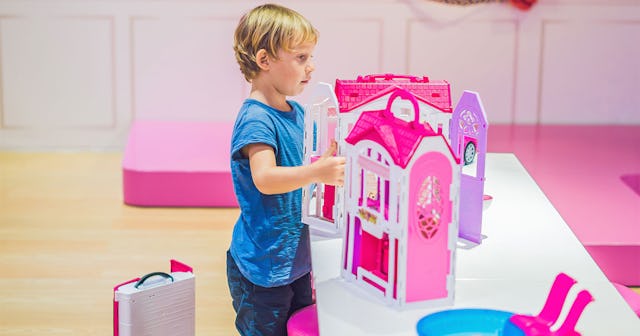Big Steps In Removing Gender Bias From Toys

LEGO has announced that they will “work to remove gender stereotypes from its toys” after they discovered the harm gender bias in toys was perpetuating in children’s choice activities. Girls were becoming more likely to engage in a wider range of activities, but boys were still frightened of being teased about playing with “girl” toys. Julia Goldin, the chief product and marketing officer at the LEGO Group, told The Guardian that, “We’re working hard to make Lego more inclusive.”
My three boys, like most kids, obsess over LEGOs. They have Star Wars LEGOs. They have dinosaur LEGOs. They have deep sea explorer LEGOs. They have Harry Potter LEGOs and Lord of the Rings LEGOs. But when I asked if they wanted any of the LEGO Friends sets, they glanced at one another. “Um… those people are the wrong size,” my middle son said. He was wearing a unicorn T-shirt. His favorite colors include amethyst. LEGO sets were clearly gender-coded by minifig size, and August’s shuffling feet told me he knew minifig size was a sign: those are for girls, Mama.
Madeline Di Nonno, chief executive of the Geena Davis Institute on Gender in Media, who LEGO commissioned to do this research, says, “Parents are more worried that their sons will be teased than their daughters for playing with toys associated with the other gender.” And I was afraid my sons’ friends would tease them if they saw LEGO Friends sets mixed in with Darth Vader. I buy my boys unicorn shirts from the girls’ department (they love unicorns, and guess what department doesn’t stock unicorn shirts?). But those LEGO Friends sets are so aggressively coded, so pink and purple, that I worried what their friends would say if they saw my sons playing wrong-sized minifigs that involve a little too much pastel.
That gender bias is going to end.
But it’s not just ending with LEGO. The state of California recently passed a bill, slated to go into effect in 2024, compelling large retailers to include a “gender-neutral” section alongside its girls’ and boys’ sections. While it doesn’t outright ban girls’ and boys’ sections, it forces retailers to create a space free of gender bias. My son was able to pick out LEGO Friends as a “girl toy” not just because of its pink-and-purple princesses, but because that line was segregated from the other LEGOs. Gender bias in toys makes a difference.
Gender Bias In Toys? It’s About More Than Toys
Westend61/Getty
Why don’t boys want to play with “girl” toys? Simple, says Di Nonno. “Behaviors associated with men are valued more highly in society… Until societies recognize that behaviors and activities typically associated with women are as valuable or important, parents and children will be tentative to embrace them.”
By enforcing gender bias in toys, we enforce harmful stereotypes about what type of work and behavior is characteristic, typical, or praise-worthy in which gender. Even darker, we enforce a negative stereotype: gender bias in toys tells boys and girls not only what to be, but what not to be. 71% of boys are afraid to play with “girl” toys because they’re afraid their friends will tease them for their association with femininity.
Prof. Gina Rippon, a neurobiologist, says, “We encourage girls to play with ‘boys’ stuff’ but not the other way around… if girls aren’t playing with LEGO or other construction toys, they aren’t developing the spatial skills that will help them in later life. If dolls are being pushed on girls but not boys, then boys are missing out on nurturing skills.” Toys, she says, were a kind of training opportunity that primed kids for skills they’d use later in life. Gender bias in toys teaches boys that nurturing isn’t as valuable as STEM, and shows girls that caregiving tops other skills.
By pushing back against that narrative, LEGO and the state of California push against those harmful stereotypes that limit children — not just in play, but in life skills and even career choices.
They Also Affect Mental Health
Gender bias in toys hits even deeper. A UK report warned that gender stereotyping “is it at the root” of eating disorders, issues with body image, record male suicide rates, and “rising violence against girls and women.” Where’s all that stereotyping start?
Toys.
Even earlier: baby products. California’s law will not only affect toys, but also “any ‘childcare items’ intended to aid sleep, relaxation, feeding, teething or sucking.” We’ll still have boys and girls areas for clothing, but everything else will be forced to include a gender-neutral space.
LEGO’s taking the lead in showing that toys don’t have to lean towards one gender or another to be fun. As a kid in the 1980s, my brother and I shared a giant tub of LEGOs. His best friend, a boy, also had a giant tub of LEGOs. Remember the little girl in the LEGO ad? She’s all grown up now and laments that, “In 1981, LEGOs were simple and gender-neutral, and the creativity of the child produced the message. In 2014, it’s the reverse: the toy delivers a message to the child, and this message is weirdly about gender.” LEGO traipsed down that gender biased road and they admit that, but they’re committed to doing better.
This mother of boys says thank you.